Advancing Building Assessment Tools: Achieving Sustainable Development Goals through the Fusion of Internet of Things Occupant-Centric Principles and Sustainable Practices
Abstract
1. Introduction
- R.Q1. Why develop a new generation of BA tools?
- R.Q2. What are the potential advancements in using the IoT with BA tools?
- R.Q3. What are the correlations between IoT occupant-centric impacts and SDGS’ targets?
2. Materials and Methods
- -
- Cluster theme 1: Evolution of occupant-centric concepts, which discuss the development of theoretical models of occupant behavior in buildings.
- -
- Cluster theme 2: Development of building performance assessment tools and rating systems, which discuss the development of assessment tools and rating systems in buildings with an understanding of the individual occupants’ usage.
- -
- Cluster theme 3: Integration of digital technologies and IoT solutions, which discusses the utilization of ICT building technology and IoT devices for understanding the individual occupants’ usage. All are discussed in detail below.
3. Results
3.1. Cluster Theme 1: Evolution of Occupant-Centric Concepts
| Code | OC Performance Indicators | Attributes | Example Ref. |
|---|---|---|---|
| O.C. M.1 | Occupant Information | Social norms, personal attitude, degree of control, comfort experience, clothing level, and activity rate. | [30,52,53] |
| O.C. M.2 | Lighting Controls/Automation | Comfort, scheduling, daylight harvesting levels, light status, and energy control. | [54,55] |
| O.C. M.3 | Indoor Environmental Quality | Humidity, air temperature, visual, acoustic, and ventilation aspects. | [56,57] |
| O.C. M.4 | HVAC Controls/Automation | Weather data, natural lighting information, natural ventilation information, comfort, scheduling, daylight harvesting levels, light status, and energy control. | [58,59] |
| O.C. M.5 | Occupant interactions | Blind, window, and fan controls. | [60,61] |
| O.C. M.6 | Space Utilization and Planning | Activities and usages, orientation and view, fenestration proportions and scale, and envelope control. | [54,55,62] |
| O.C. M.7 | Building Operations | Energy control, management, and facility systems. | [63,64] |
A New Paradigm for Occupant-Centric Control
3.2. Cluster Theme 2: Building Performance Assessment Tools and Rating Systems
3.3. Cluster Theme 3: Integration of Digital Technologies and IoT Solutions
4. Discussion
4.1. Intersectional Areas of IoT Occupant-Centric Concepts between Sustainability and SDGs’ Targets
4.2. IoT Occupant-Centric and New Concepts for Building Assessment Tools
4.3. Current and Future Possible Research Areas
4.4. Challenges and Recommendations
- -
- Gaining a more profound insight into occupant-centric interactions is essential to narrow the gap between the anticipated and actual BOP. This involves addressing the challenges associated with incorporating factors related to building occupants and their behavior into the decision-making process of building design.
- -
- Standardizing the utilization of IoT and smart readiness, coupled with explicit strategies, is pivotal in exploring diverse interdisciplinary approaches to tackle future challenges posed by climate change and smart technologies.
- -
- Delving into the levels of building functionality and the varied uses of spaces constitutes a crucial method for achieving circularity in building practices. Further research on building processes and monitoring is imperative for the successful promotion of circular building strategies.
- -
- The examination of occupant satisfaction should extend to considering participant characteristics, like gender, age, proximity to windows, and work history within buildings. These non-environmental factors significantly influence satisfaction levels within building environments.
- -
- A more in-depth exploration of the relationship between energy consumption and occupant satisfaction is necessary for a comprehensive understanding of performance attributes, enabling more accurate predictions of building performance.
- -
- Developing a set of guidelines and benchmarks for assessing the energy efficiency of buildings and subsequently using these metrics to shape the creation of a novel building performance assessment tool is a crucial step in advancing sustainable building practices.
5. Conclusions
Supplementary Materials
Author Contributions
Funding
Data Availability Statement
Conflicts of Interest
List of Abbreviations
| AI | Artificial Intelligence |
| BA Tool | Building Assessment Tool |
| BIM | Building Information Modeling |
| BOP | Building Operational Performance |
| DPCs | Dynamic Energy Performance Certificates |
| EU | European Union |
| EPBD | Energy Performance of Buildings Directive |
| EPCs | Energy Performance Certificates |
| IoT | Internet of Things |
| IoT OC | IoT Occupant-Centric |
| OB | Occupant Behavior |
| OC | Occupant-Centric |
| SBs | Smart Buildings |
| SDGs | Sustainable Development Goals |
| SRIs | Smart Readiness Indicators |
References
- United Nations. The Sustainable Development Goals Report. 2023. Available online: https://unstats.un.org/sdgs/report/2023/ (accessed on 16 November 2023).
- Allen, C.; Malekpour, S. Unlocking and Accelerating Transformations to the SDGs: A Review of Existing Knowledge. Sustain. Sci. 2023, 18, 1939–1960. [Google Scholar] [CrossRef] [PubMed]
- IEA50. World Energy Outlook 2023—Analysis—IEA. Available online: https://www.iea.org/reports/world-energy-outlook-2023 (accessed on 26 February 2024).
- European Commission. Energy—European Commission. Available online: https://energy.ec.europa.eu/index_en (accessed on 26 February 2024).
- Omrany, H.; Chang, R.; Soebarto, V.; Zhang, Y.; Ghaffarianhoseini, A.; Zuo, J. A Bibliometric Review of Net Zero Energy Building Research 1995–2022. Energy Build. 2022, 262, 111996. [Google Scholar] [CrossRef]
- Lu, Y.; Wu, Z.; Chang, R.; Li, Y. Building Information Modeling (BIM) for Green Buildings: A Critical Review and Future Directions. Autom. Constr. 2017, 83, 134–148. [Google Scholar] [CrossRef]
- Inayat, A.; Raza, M. District Cooling System via Renewable Energy Sources: A Review. Renew. Sustain. Energy Rev. 2019, 107, 360–373. [Google Scholar] [CrossRef]
- European Commission. Proposal for a Directive of the European Parliament and of the Council on the Energy Performance of Buildings. Eur. Union 2021, 426, 10–27. Available online: https://eur-lex.europa.eu/legal-content/EN/TXT/?uri=CELEX%3A52021PC0802 (accessed on 26 February 2024).
- Lim, Y.W.; Chong, H.Y.; Ling, P.C.H.; Tan, C.S. Greening Existing Buildings through Building Information Modelling: A Review of the Recent Development. Build. Environ. 2021, 200, 107924. [Google Scholar] [CrossRef]
- Azizi, S.; Nair, G.; Rabiee, R.; Olofsson, T. Application of Internet of Things in Academic Buildings for Space Use Efficiency Using Occupancy and Booking Data. Build. Environ. 2020, 186, 107355. [Google Scholar] [CrossRef] [PubMed]
- Scislo, L.; Szczepanik-Scislo, N. Near Real-Time Access Monitoring Based on IoT Dynamic Measurements of Indoor Air Pollutant. In Proceedings of the 2023 IEEE 12th International Conference on Intelligent Data Acquisition and Advanced Computing Systems: Technology and Applications (IDAACS), Dortmund, Germany, 7–9 September 2023; pp. 729–734. [Google Scholar] [CrossRef]
- Shareef, S.S.; Rauf, H.L. Integrating Internet of Things Technologies for Dynamic Sustainability in Architectural Design. Emerg. Technol. Eng. J. 2024, 1, 26–42. [Google Scholar] [CrossRef]
- Tagliabue, L.C.; Re Cecconi, F.; Rinaldi, S.; Ciribini, A.L.C. Data Driven Indoor Air Quality Prediction in Educational Facilities Based on IoT Network. Energy Build. 2021, 236, 110782. [Google Scholar] [CrossRef]
- Lohan, V.; Singh, R.P. Home Automation Using Internet of Things. In Advances in Data and Information Sciences; Lecture Notes in Networks and Systems; Springer: Singapore, 2019; Volume 39, pp. 293–301. [Google Scholar] [CrossRef]
- Bajer, M. IoT for Smart Buildings—Long Awaited Revolution or Lean Evolution. In Proceedings of the 2018 IEEE 6th International Conference on Future Internet of Things and Cloud (FiCloud), Barcelona, Spain, 6–8 August 2018; pp. 149–154. [Google Scholar] [CrossRef]
- Rafsanjani, H.N.; Ghahramani, A.; Nabizadeh, A.H. ISEA: IoT-Based Smartphone Energy Assistant for Prompting Energy-Aware Behaviors in Commercial Buildings. Appl. Energy 2020, 266, 114892. [Google Scholar] [CrossRef]
- An, J.; Yan, D.; Hong, T.; Sun, K. A Novel Stochastic Modeling Method to Simulate Cooling Loads in Residential Districts. Appl. Energy 2017, 206, 134–149. [Google Scholar] [CrossRef]
- Chiesa, G.; Avignone, A.; Carluccio, T. A Low-Cost Monitoring Platform and Visual Interface to Analyse Thermal Comfort in Smart Building Applications Using a Citizen–Scientist Strategy. Energies 2022, 15, 564. [Google Scholar] [CrossRef]
- Bavaresco, M.V.; D’Oca, S.; Ghisi, E.; Pisello, A.L. Assessing Underlying Effects on the Choices of Adaptive Behaviours in Offices through an Interdisciplinary Framework. Build. Environ. 2020, 181, 107086. [Google Scholar] [CrossRef]
- Al Dakheel, J.; Del Pero, C.; Aste, N.; Leonforte, F. Smart Buildings Features and Key Performance Indicators: A Review. Sustain. Cities Soc. 2020, 61, 102328. [Google Scholar] [CrossRef]
- Hossain, M.; Weng, Z.; Schiano-Phan, R.; Scott, D.; Lau, B. Application of IoT and BEMS to Visualise the Environmental Performance of an Educational Building. Energies 2020, 13, 4009. [Google Scholar] [CrossRef]
- Paone, A.; Bacher, J.P. The Impact of Building Occupant Behavior on Energy Efficiency and Methods to Influence It: A Review of the State of the Art. Energies 2018, 11, 953. [Google Scholar] [CrossRef]
- Xie, J.; Li, H.; Li, C.; Zhang, J.; Luo, M. Review on Occupant-Centric Thermal Comfort Sensing, Predicting, and Controlling. Energy Build. 2020, 226, 110392. [Google Scholar] [CrossRef]
- Yan, D.; Hong, T.; Dong, B.; Mahdavi, A.; D’Oca, S.; Gaetani, I.; Feng, X. IEA EBC Annex 66: Definition and Simulation of Occupant Behavior in Buildings. Energy Build. 2017, 156, 258–270. [Google Scholar] [CrossRef]
- Kanters, J. Circular Building Design: An Analysis of Barriers and Drivers for a Circular Building Sector. Buildings 2020, 10, 77. [Google Scholar] [CrossRef]
- Kaewunruen, S.; Rungskunroch, P.; Welsh, J. A Digital-Twin Evaluation of Net Zero Energy Building for Existing Buildings. Sustainability 2019, 11, 159. [Google Scholar] [CrossRef]
- Tam, V.W.Y.; Almeida, L.; Le, K. Energy-Related Occupant Behaviour and Its Implications in Energy Use: A Chronological Review. Sustainability 2018, 10, 2635. [Google Scholar] [CrossRef]
- Rafsanjani, H.N.; Ghahramani, A. Towards Utilizing Internet of Things (IoT) Devices for Understanding Individual Occupants’ Energy Usage of Personal and Shared Appliances in Office Buildings. J. Build. Eng. 2020, 27, 100948. [Google Scholar] [CrossRef]
- Zuhaib, S.; Schmatzberger, S.; Volt, J.; Toth, Z.; Kranzl, L.; Eugenio Noronha Maia, I.; Verheyen, J.; Borragán, G.; Monteiro, C.S.; Mateus, N.; et al. Next-Generation Energy Performance Certificates: End-User Needs and Expectations. Energy Policy 2022, 161, 112723. [Google Scholar] [CrossRef]
- Elshaboury, N. Investigating the Occupant Existence to Reduce Energy Consumption by Using a Hybrid Artificial Neural Network with Metaheuristic Algorithms. Decis. Sci. Lett. 2022, 11, 91–104. [Google Scholar] [CrossRef]
- Vermesan, O.; Bacquet, J. Cognitive Hyperconnected Digital Transformation: Internet of Things Intelligence Evolution; River Publishers: Aalborg, Denmark, 2017; pp. 1–310. [Google Scholar]
- Srivastava, S.; Dev, S.; Bajaj, B. Human Resource Information System Use, Satisfaction, and Success. In Research Anthology on Human Resource Practices for the Modern Workforce; IGI Global: Hershey, PA, USA, 2021; pp. 491–512. [Google Scholar] [CrossRef]
- Naspi, F.; Arnesano, M.; Stazi, F.; D’Orazio, M.; Revel, G.M. Measuring Occupants’ Behaviour for Buildings’ Dynamic Cosimulation. J. Sens. 2018, 2018, 2756542. [Google Scholar] [CrossRef]
- Atamewan, E.E. Appraisal of Day-Lighting in Sustainable Housing Development in Developing Countries. J. Stud. Sci. Eng. 2022, 2, 59–75. [Google Scholar] [CrossRef]
- van de Schoot, R.; de Bruin, J.; Schram, R.; Zahedi, P.; de Boer, J.; Weijdema, F.; Kramer, B.; Huijts, M.; Hoogerwerf, M.; Ferdinands, G.; et al. An Open Source Machine Learning Framework for Efficient and Transparent Systematic Reviews. Nat. Mach. Intell. 2021, 3, 125–133. [Google Scholar] [CrossRef]
- Page, M.J.; McKenzie, J.E.; Bossuyt, P.M.; Boutron, I.; Hoffmann, T.C.; Mulrow, C.D.; Shamseer, L.; Tetzlaff, J.M.; Akl, E.A.; Brennan, S.E.; et al. The PRISMA 2020 Statement: An Updated Guideline for Reporting Systematic Reviews. Int. J. Surg. 2021, 88, 105906. [Google Scholar] [CrossRef] [PubMed]
- Kong, M.; Dong, B.; Zhang, R.; O’Neill, Z. HVAC Energy Savings, Thermal Comfort and Air Quality for Occupant-Centric Control through a Side-by-Side Experimental Study. Appl. Energy 2022, 306, 117987. [Google Scholar] [CrossRef]
- O’Brien, W.; Wagner, A.; Schweiker, M.; Mahdavi, A.; Day, J.; Kjærgaard, M.B.; Carlucci, S.; Dong, B.; Tahmasebi, F.; Yan, D.; et al. Introducing IEA EBC Annex 79: Key Challenges and Opportunities in the Field of Occupant-Centric Building Design and Operation. Build. Environ. 2020, 178, 106738. [Google Scholar] [CrossRef]
- Park, J.Y.; Ouf, M.M.; Gunay, B.; Peng, Y.; O’Brien, W.; Kjærgaard, M.B.; Nagy, Z. A Critical Review of Field Implementations of Occupant-Centric Building Controls. Build. Environ. 2019, 165, 106351. [Google Scholar] [CrossRef]
- Sun, K.; Hong, T. A Framework for Quantifying the Impact of Occupant Behavior on Energy Savings of Energy Conservation Measures. Energy Build. 2017, 146, 383–396. [Google Scholar] [CrossRef]
- Yoshino, H.; Hong, T.; Nord, N. IEA EBC Annex 53: Total Energy Use in Buildings—Analysis and Evaluation Methods. Energy Build. 2017, 152, 124–136. [Google Scholar] [CrossRef]
- Bourgeois, D.; Reinhart, C.; Macdonald, I. Adding Advanced Behavioural Models in Whole Building Energy Simulation: A Study on the Total Energy Impact of Manual and Automated Lighting Control. Energy Build. 2006, 38, 814–823. [Google Scholar] [CrossRef]
- European Commission. 2030 Climate Target Plan. J. Chem. Inf. Model. 2020, 53, 1689–1699. [Google Scholar]
- Ullah, W.; Noor, S.; Tariq, A. The Development of a Basic Framework for the Sustainability of Residential Buildings in Pakistan. Sustain. Cities Soc. 2018, 40, 365–371. [Google Scholar] [CrossRef]
- ISO 6241-1984; INTERNATIONAL Performance Standards in Buildings. Available online: https://www.google.com.eg/search?q=ISO+6241-1984&sca_esv=dc0419fb69eefd49&sca_upv=1&sxsrf=ADLYWILZ_AltMkZBVWh0OBYVrTq25IGbA%3A1718182111553&source=hp&ei=32BpZuPtHq6Ai-gPsoWtkA0&iflsig=AL9hbdgAAAAAZmlu7zaJayVONYVNv0GBp_F4OouQtCxU (accessed on 12 June 2024).
- Ferrara, M.; Monetti, V.; Fabrizio, E. Cost-Optimal Analysis for Nearly Zero Energy Buildings Design and Optimization: A Critical Review. Energies 2018, 11, 1478. [Google Scholar] [CrossRef]
- Sangiorgi, M.; Angel Hernández-Ceballos, M.; Jackson, K.; Cinelli, G.; Bogucarskis, K.; De Felice, L.; Patrascu, A.; De Cort, M. The European Radiological Data Exchange Platform (EURDEP): 25 Years of Monitoring Data Exchange. Earth Syst. Sci. Data 2020, 12, 109–118. [Google Scholar] [CrossRef]
- BPIE. BPIE Is a Leading Independent Centre of Expertise on Energy Performance of Buildings. BPIE—Buildings Performance Institute Europe. Available online: https://www.bpie.eu/ (accessed on 4 November 2023).
- Junker, R.G.; Azar, A.G.; Lopes, R.A.; Lindberg, K.B.; Reynders, G.; Relan, R.; Madsen, H. Characterizing the Energy Flexibility of Buildings and Districts. Appl. Energy 2018, 225, 175–182. [Google Scholar] [CrossRef]
- Lavy, S.; Garcia, J.A.; Dixit, M.K. Establishment of KPIs for Facility Performance Measurement: Review of Literature. Facilities 2010, 28, 440–464. [Google Scholar] [CrossRef]
- Kahraman, C.; Çevik, S.; Ates, N.Y.; Gülbay, M. Fuzzy Multi-Criteria Evaluation of Industrial Robotic Systems. Comput. Ind. Eng. 2007, 52, 414–433. [Google Scholar] [CrossRef]
- Delzendeh, E.; Wu, S.; Lee, A.; Zhou, Y. The Impact of Occupants’ Behaviours on Building Energy Analysis: A Research Review. Renew. Sustain. Energy Rev. 2017, 80, 1061–1071. [Google Scholar] [CrossRef]
- Gupta, S.K.; Atkinson, S.; O’Boyle, I.; Drogo, J.; Kar, K.; Mishra, S.; Wen, J.T. BEES: Real-Time Occupant Feedback and Environmental Learning Framework for Collaborative Thermal Management in Multi-Zone, Multi-Occupant Buildings. Energy Build. 2016, 125, 142–152. [Google Scholar] [CrossRef]
- Khandavilli, S. Intel Creates Smart Building Using IoT Intel’s Smart Building Increases Energy Conservation, Operational Efficiency, and Occupant Comfort. Inflexible Propr. Solut. 2016, 1–6. Available online: https://www.intel.com/content/www/us/en/smart-buildings/overview.html (accessed on 12 June 2024).
- Cedeno Laurent, J.G.; Samuelson, H.W.; Chen, Y. The Impact of Window Opening and Other Occupant Behavior on Simulated Energy Performance in Residence Halls. Build. Simul. 2017, 10, 963–976. [Google Scholar] [CrossRef]
- Oldewurtel, F.; Parisio, A.; Jones, C.N.; Gyalistras, D.; Gwerder, M.; Stauch, V.; Lehmann, B.; Morari, M. Use of Model Predictive Control and Weather Forecasts for Energy Efficient Building Climate Control. Energy Build. 2012, 45, 15–27. [Google Scholar] [CrossRef]
- Li, Z.; Tian, M.; Zhu, X.; Xie, S.; He, X. A Review of Integrated Design Process for Building Climate Responsiveness. Energies 2022, 15, 7133. [Google Scholar] [CrossRef]
- Bengea, S.C.; Kelman, A.D.; Borrelli, F.; Taylor, R.; Narayanan, S. Implementation of Model Predictive Control for an HVAC System in a Mid-Size Commercial Building. HVACR Res. 2014, 20, 121–135. [Google Scholar] [CrossRef]
- Aftab, M.; Chen, C.; Chau, C.-K.; Rahwan, T. Automatic HVAC Control with Real-Time Occupancy Recognition and Simulation-Guided Model Predictive Control in Low-Cost Embedded System. Energy Build. 2017, 154, 141–156. [Google Scholar] [CrossRef]
- Andersen, R.V.; Toftum, J.; Andersen, K.K.; Olesen, B.W. Survey of Occupant Behaviour and Control of Indoor Environment in Danish Dwellings. Energy Build. 2009, 41, 11–16. [Google Scholar] [CrossRef]
- Calì, D.; Andersen, R.K.; Müller, D.; Olesen, B.W. Analysis of Occupants’ Behavior Related to the Use of Windows in German Households. Build. Environ. 2016, 103, 54–69. [Google Scholar] [CrossRef]
- Zhang, Y.; Yang, Q. Assessing Hotel Decision-Making of Disabled Guests: Satisfaction Correlation Study between Online Comments’ Credibility and Perceived Risk. Electron. Commer. Res. 2021, 21, 767–786. [Google Scholar] [CrossRef]
- Kasim, H.; Che Hassan, C.R.; Hamid, M.D.; Emami, S.D.; Danaee, M. Determination of Factors Affecting Safety Practices in Malaysian Radiation Facilities. Saf. Sci. 2018, 104, 70–80. [Google Scholar] [CrossRef]
- Sharma, S.K.; Mohapatra, S.; Sharma, R.C.; Alturjman, S.; Altrjman, C.; Mostarda, L.; Stephan, T. Retrofitting Existing Buildings to Improve Energy Performance. Sustainability 2022, 14, 666. [Google Scholar] [CrossRef]
- Baharetha, S.M.; Al-Hammad, A.A.; Alshuwaikhat, H.M. Towards a Unified Set of Sustainable Building Materials Criteria. In Proceedings of the ICSDEC 2012: Developing the Frontier of Sustainable Design, Engineering, and Construction, Fort Worth, TX, USA, 7–9 November 2012; pp. 732–740. [Google Scholar] [CrossRef]
- Warren, C.M.J.; Bienert, S.; Warren-Myers, G. Valuation and Sustainability Are Rating Tools Enough? In Proceedings of the European Real Estate Society Conference, Stockholm, Sweden, 24–27 June 2009.
- Thanu, H.P.; Rajasekaran, C.; Deepak, M.D. Developing a Building Performance Score Model for Assessing the Sustainability of Buildings. Smart Sustain. Built Environ. 2022, 11, 143–161. [Google Scholar] [CrossRef]
- Richalet, V.; Neirac, F.P.; Tellez, F.; Marco, J.; Bloem, J.J. HELP (House Energy Labeling Procedure): Methodology and Present Results. Energy Build. 2001, 33, 229–233. [Google Scholar] [CrossRef]
- Wang, S.; Yan, C.; Xiao, F. Quantitative Energy Performance Assessment Methods for Existing Buildings. Energy Build. 2012, 55, 873–888. [Google Scholar] [CrossRef]
- Newsham, G.R.; Mancini, S.; Birt, B.J. Do LEED-Certified Buildings Save Energy? Yes, But…. Energy Build. 2009, 41, 897–905. [Google Scholar] [CrossRef]
- GB 50411-2007; Chinese Standard GB/T. Available online: https://www.chinesestandard.net/PDF/English.aspx/GB50411-2007 (accessed on 12 June 2024).
- ASHRAE. Available online: https://www.ashrae.org/technical-resources/standards-and-guidelines (accessed on 29 June 2023).
- GB/T 18883-2002; Chinese Standard GB/T. Available online: https://www.chinesestandard.net/PDF.aspx/GBT18883-2002 (accessed on 12 June 2024).
- GB/T 7106-2008; Chinese Standard GB/T. Available online: https://www.chinesestandard.net/PDF/English.aspx/GBT7106-2008 (accessed on 12 June 2024).
- Gupta, R.; Kapsali, M.; Howard, A. Evaluating the Influence of Building Fabric, Services and Occupant Related Factors on the Actual Performance of Low Energy Social Housing Dwellings in UK. Energy Build. 2018, 174, 548–562. [Google Scholar] [CrossRef]
- RIBA. Microsoft Digital Transformation in Architecture. NBS Res. 2018, 1–46. [Google Scholar]
- Lê, Q.; Nguyen, H.B.; Barnett, T. Smart Homes for Older People: Positive Aging in a Digital World. Future Internet 2012, 4, 607–617. [Google Scholar] [CrossRef]
- Yu, Z.; Fung, B.C.M.; Haghighat, F.; Yoshino, H.; Morofsky, E. A Systematic Procedure to Study the Influence of Occupant Behavior on Building Energy Consumption. Energy Build. 2011, 43, 1409–1417. [Google Scholar] [CrossRef]
- Soebarto, V.I.; Williamson, T.J. Multi-Criteria Assessment of Building Performance: Theory and Implementation. Build. Environ. 2001, 36, 681–690. [Google Scholar] [CrossRef]
- Fathy, F.; Mansour, Y.; Sabry, H.; Refat, M.; Wagdy, A. Conceptual Framework for Daylighting and Facade Design in Museums and Exhibition Spaces. Sol. Energy 2020, 204, 673–682. [Google Scholar] [CrossRef]
- El-Motasem, S.; Eid, A.F.; Khodeir, L.M. Identification of Key Challenges of Smart Buildings Projects in Egypt. Acad. Res. Community Publ. 2020, 4, 34–43. [Google Scholar] [CrossRef]
- Bottaccioli, L.; Aliberti, A.; Ugliotti, F.; Patti, E.; Osello, A.; Macii, E.; Acquaviva, A. Building Energy Modelling and Monitoring by Integration of IoT Devices and Building Information Models. In Proceedings of the 2017 IEEE 41st Annual Computer Software and Applications Conference (COMPSAC), Turin, Italy, 4–8 July 2017; Volume 1, pp. 914–922. [Google Scholar] [CrossRef]
- Addy, M.N.; Adinyira, E.; Ayarkwa, J. Identifying and Weighting Indicators of Building Energy Efficiency Assessment in Ghana. Energy Procedia 2017, 134, 161–170. [Google Scholar] [CrossRef]
- Gupta, M.; Thammi, S.K. A Study of the Application of Technology Acceptance Model (TAM) to E Learning among Undergraduate Students in India—A Structural Equation Modelling Approach. Asian J. Manag. 2021, 12, 243–252. [Google Scholar] [CrossRef]
- Leaman, A.; Stevenson, F.; Bordass, B. Building Evaluation: Practice and Principles. Build. Res. Inf. 2010, 38, 564–577. [Google Scholar] [CrossRef]
- Fabi, V.; Andersen, R.K.; Corgnati, S. Verification of Stochastic Behavioural Models of Occupants’ Interactions with Windows in Residential Buildings. Build. Environ. 2015, 94, 371–383. [Google Scholar] [CrossRef]
- Khan, A.; Sepasgozar, S.; Liu, T.; Yu, R. Integration of BIM and Immersive Technologies for AEC: A Scientometric-SWOT Analysis and Critical Content Review. Buildings 2021, 11, 126. [Google Scholar] [CrossRef]
- Francis, A.; Thomas, A. A Framework for Dynamic Life Cycle Sustainability Assessment and Policy Analysis of Built Environment through a System Dynamics Approach. Sustain. Cities Soc. 2022, 76, 103521. [Google Scholar] [CrossRef]
- Apanaviciene, R.; Vanagas, A.; Fokaides, P.A. Smart Building Integration into a Smart City (SBISC): Development of a New Evaluation Framework. Energies 2020, 13, 2190. [Google Scholar] [CrossRef]
- Siemens. Crystal Clear, Deploying KNX in One of the World’s Greenest Buildings; Abtec Building Technologies Ltd.: Market Harborough, UK, 2015. [Google Scholar]
- Hong, T.; Yan, D.; D’Oca, S.; Chen, C.-F. Ten Questions Concerning Occupant Behavior in Buildings: The Big Picture. Build. Environ. 2017, 114, 518–530. [Google Scholar] [CrossRef]
- Bhavsingh, M.; Samunnisa, K.; Mallareddy, A. Enhancing Efficiency and Security in MTC Environments: A Novel Strategy for Dynamic Grouping and Streamlined Management. Emerg. Technol. Eng. J. 2024, 1, 43–56. [Google Scholar] [CrossRef]
- Buckman, A.H.; Mayfield, M.; Beck, S.B.M. What Is a Smart Building? Smart Sustain. Built Environ. 2014, 3, 92–109. [Google Scholar] [CrossRef]
- Mckinsey & Company. Technology Media and Telecommunications; 2015. Available online: https://www.mckinsey.com/industries/technology-media-and-telecommunications/our-insights/global-media-report-2015#/ (accessed on 12 June 2024).
- Lee, H.J.; Kim, M. The Internet of Things in a Smart Connected World; IntechOpen: London, UK, 2018. [Google Scholar] [CrossRef]
- David, J.; Priestley, A.; Tan, S.; Hare, J. The Business Value of Artificial Intelligence Worldwide from 2017–2025; Gartner Inc.: Stamford, CT, USA, 2018. [Google Scholar]
- Schneider Electric. Get Connected: Smart Buildings and the Internet of Things; Schneider Electric: Andover, MA, USA, 2018. [Google Scholar]
- European Commission. Roadmap 2050; European Union: Brussels, Belgium, 2012; pp. 3–19. [Google Scholar]
- UNESCO. UNESCO Recommendation on Open Science|UNESCO. Available online: https://www.unesco.org/en/open-science/about?hub=686 (accessed on 16 November 2023).
- Poongothai, M.; Subramanian, P.M.; Rajeswari, A. Design and Implementation of IoT Based Smart Laboratory. In Proceedings of the 2018 5th International Conference on Industrial Engineering and Applications (ICIEA), Singapore, 26–28 April 2018; pp. 169–173. [Google Scholar] [CrossRef]
- Dong, B.; Lam, K.P. Building Energy and Comfort Management through Occupant Behaviour Pattern Detection Based on a Large-Scale Environmental Sensor Network. J. Build. Perform. Simul. 2011, 4, 359–369. [Google Scholar] [CrossRef]
- Yang, R.; Wang, L. Multi-Objective Optimization for Decision-Making of Energy and Comfort Management in Building Automation and Control. Sustain. Cities Soc. 2012, 2, 1–7. [Google Scholar] [CrossRef]
- Verma, A.; Prakash, S.; Kumar, A. AI-Based Building Management and Information System with Multi-Agent Topology for an Energy-Efficient Building: Towards Occupants Comfort. IETE J. Res. 2020, 69, 1033–1044. [Google Scholar] [CrossRef]
- Chen, C.; Cook, D.J.; Crandall, A.S. The User Side of Sustainability: Modeling Behavior and Energy Usage in the Home. Pervasive Mob. Comput. 2013, 9, 161–175. [Google Scholar] [CrossRef]
- Metwally, E.A.; Farid, A.A.; Ismail, M.R. Development of an IoT Assessment Method: An Interdisciplinary Framework for Energy Efficient Buildings. Energy Build. 2022, 254, 111545. [Google Scholar] [CrossRef]
- Alletto, S.; Cucchiara, R.; Del Fiore, G.; Mainetti, L.; Mighali, V.; Patrono, L.; Serra, G. An Indoor Location-Aware System for an IoT-Based Smart Museum. IEEE Internet Things J. 2016, 3, 244–253. [Google Scholar] [CrossRef]
- Casini, M. Internet of Things for Energy Efficiency of Buildings. Int. Sci. J. Archit. Eng. 2014, 2, 24–28. [Google Scholar]
- Yang, J.; Wang, Z.; Zhang, X. An IBeacon-Based Indoor Positioning Systems for Hospitals. Int. J. Smart Home 2015, 9, 161–168. [Google Scholar] [CrossRef]
- Jalia, A.; Bakker, R. The Edge, Amsterdam; Centre for Digital Built Britain, University of Cambridge: Cambridge, UK, 2019. [Google Scholar]
- Industries, C. IoT on HVAC/R Systems, How Connectivity Will Increase Efficiency? CAREL Knowledge Center: Brugine, Italy, 2016. [Google Scholar]
- Jain, R.; Goel, V.; Rekhi, J.K.; Alzubi, J.A. IoT-Based Green Building; IGI Global: Hershey, PA, USA, 2019; pp. 184–207. [Google Scholar] [CrossRef]
- Nguyen, B.K.; Altan, H. Comparative Review of Five Sustainable Rating Systems. Procedia Eng. 2011, 21, 376–386. [Google Scholar] [CrossRef]
- Gill, Z.M.; Tierney, M.J.; Pegg, I.M.; Allan, N. Low-Energy Dwellings: The Contribution of Behaviours to Actual Performance. Build. Res. Inf. 2010, 38, 491–508. [Google Scholar] [CrossRef]
- Dascalaki, E.G.; Balaras, C.A.; Gaglia, A.G.; Droutsa, K.G.; Kontoyiannidis, S. Energy Performance of Buildings-EPBD in Greece. Energy Policy 2012, 45, 469–477. [Google Scholar] [CrossRef]
- Altomonte, S.; Allen, J.; Bluyssen, P.M.; Brager, G.; Heschong, L.; Loder, A.; Schiavon, S.; Veitch, J.A.; Wang, L.; Wargocki, P. Ten Questions Concerning Well-Being in the Built Environment. Build. Environ. 2020, 180, 106949. [Google Scholar] [CrossRef]
- Husiev, O.; Campos-Celador, A.; Álvarez-Sanz, M.; Terés-Zubiaga, J. Why District Renovation Is Not Leading the Race? Critical Assessment of Building Renovation Potential under Different Intervention Levels. Energy Build. 2023, 295, 113288. [Google Scholar] [CrossRef]
- Märzinger, T.; Österreicher, D. Extending the Application of the Smart Readiness Indicator—A Methodology for the Quantitative Assessment of the Load Shifting Potential of Smart Districts. Energies 2020, 13, 3507. [Google Scholar] [CrossRef]
- Võsa, K.V.; Ferrantelli, A.; Tzanev, D.; Simeonov, K.; Carnero, P.; Espigares, C.; Escudero, M.N.; Quiles, P.V.; Andrieu, T.; Battezzati, F.; et al. Building Performance Indicators and IEQ Assessment Procedure for the next Generation of EPC-s. E3S Web Conf. 2021, 246, 13003. [Google Scholar] [CrossRef]
- Fnais, A.; Rezgui, Y.; Petri, I.; Beach, T.; Yeung, J.; Ghoroghi, A.; Kubicki, S. The Application of Life Cycle Assessment in Buildings: Challenges, and Directions for Future Research. Int. J. Life Cycle Assess. 2022, 27, 627–654. [Google Scholar] [CrossRef]
- Zhang, S. The Application of the Internet of Things to Enhance Urban Sustainability. University of Michigan. 2017, pp. 102–111. Available online: https://deepblue.lib.umich.edu/handle/2027.42/136581 (accessed on 25 February 2024).
- Mohammed, Z.K.A.; Ahmed, E.S.A. Internet of Things Applications, Challenges and Related Future Technologies. World Sci. News 2017, 67, 126–148. [Google Scholar]
- Thirdview. IoT and SDGs: Digital Innovation for a Sustainable Future—Thirdview. Available online: https://thirdview.info/2023/10/19/iot-and-sdgs-digital-innovation-for-a-sustainable-future/ (accessed on 25 February 2024).
- Alam, M.; Devjani, M.R. Analyzing Energy Consumption Patterns of an Educational Building through Data Mining. J. Build. Eng. 2021, 44, 103385. [Google Scholar] [CrossRef]
- Jiang, P.; Chen, Y.; Xu, B.; Dong, W.; Kennedy, E. Building Low Carbon Communities in China: The Role of Individual’s Behaviour Change and Engagement. Energy Policy 2013, 60, 611–620. [Google Scholar] [CrossRef]
- Arafat, M.Y.; Faggal, A.A.; Khodeir, L.; Refaat, T. Customizing the Green Pyramid Rating System for Assessing University Buildings’ Sustainability: A Stakeholder-Involved Weighting Approach. Alex. Eng. J. 2023, 82, 446–458. [Google Scholar] [CrossRef]
- Mendez-Monroy, P.E.; Cruz May, E.; Jiménez Torres, M.; Gómez Hernández, J.L.; Canto Romero, M.; Sanchez Dominguez, I.; May Tzuc, O.; Bassam, A. IoT System for the Continuous Electrical and Environmental Monitoring into Mexican Social Housing Evaluated under Tropical Climate Conditions. J. Sens. 2022, 2022, 5508713. [Google Scholar] [CrossRef]
- Atamewan, E.E. Application of Sustainable Architectural Design Principles to Enhance Ecotourism in Cross River State, Nigeria. J. Stud. Sci. Eng. 2023, 3, 1–13. [Google Scholar] [CrossRef]


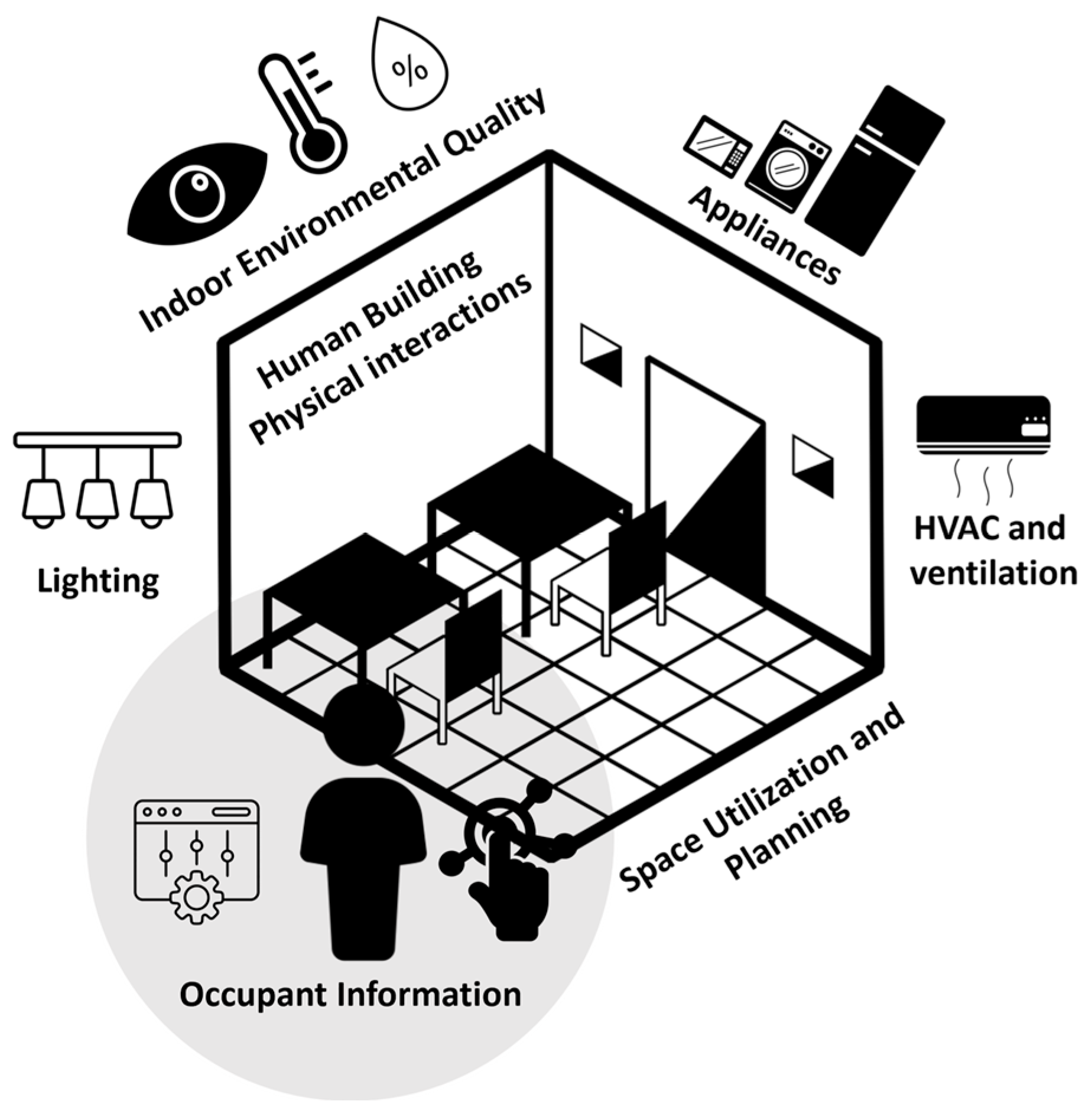

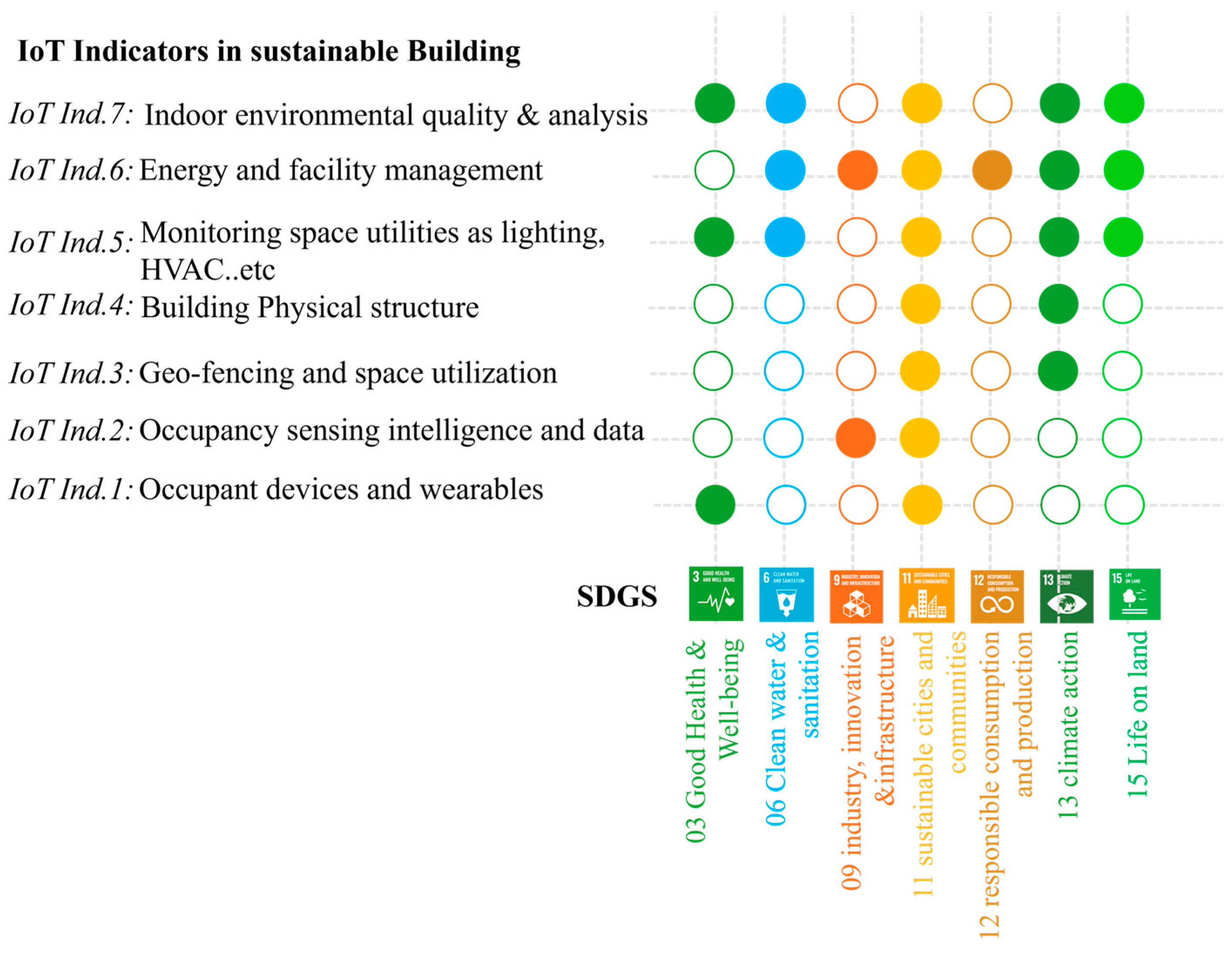
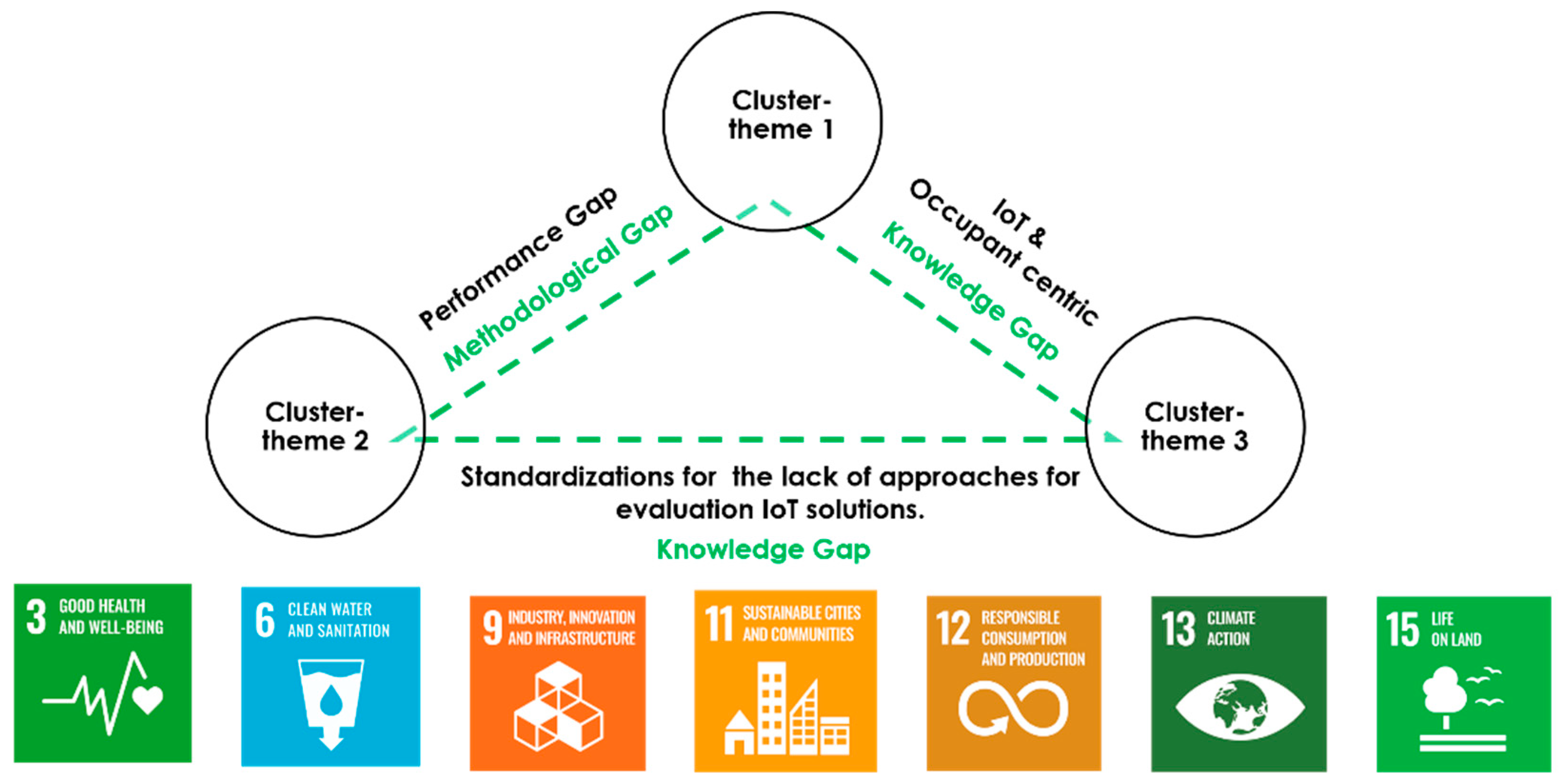
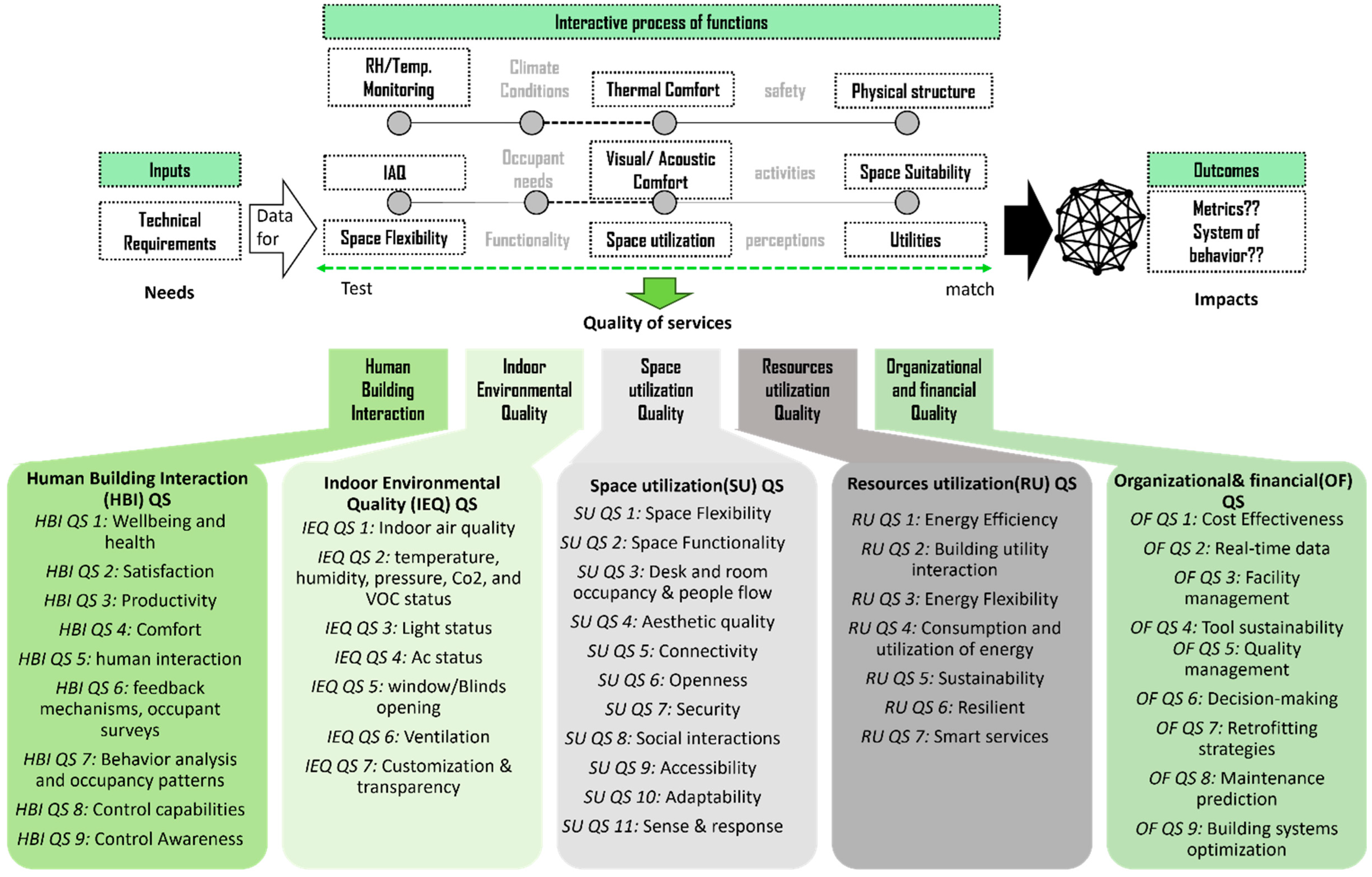
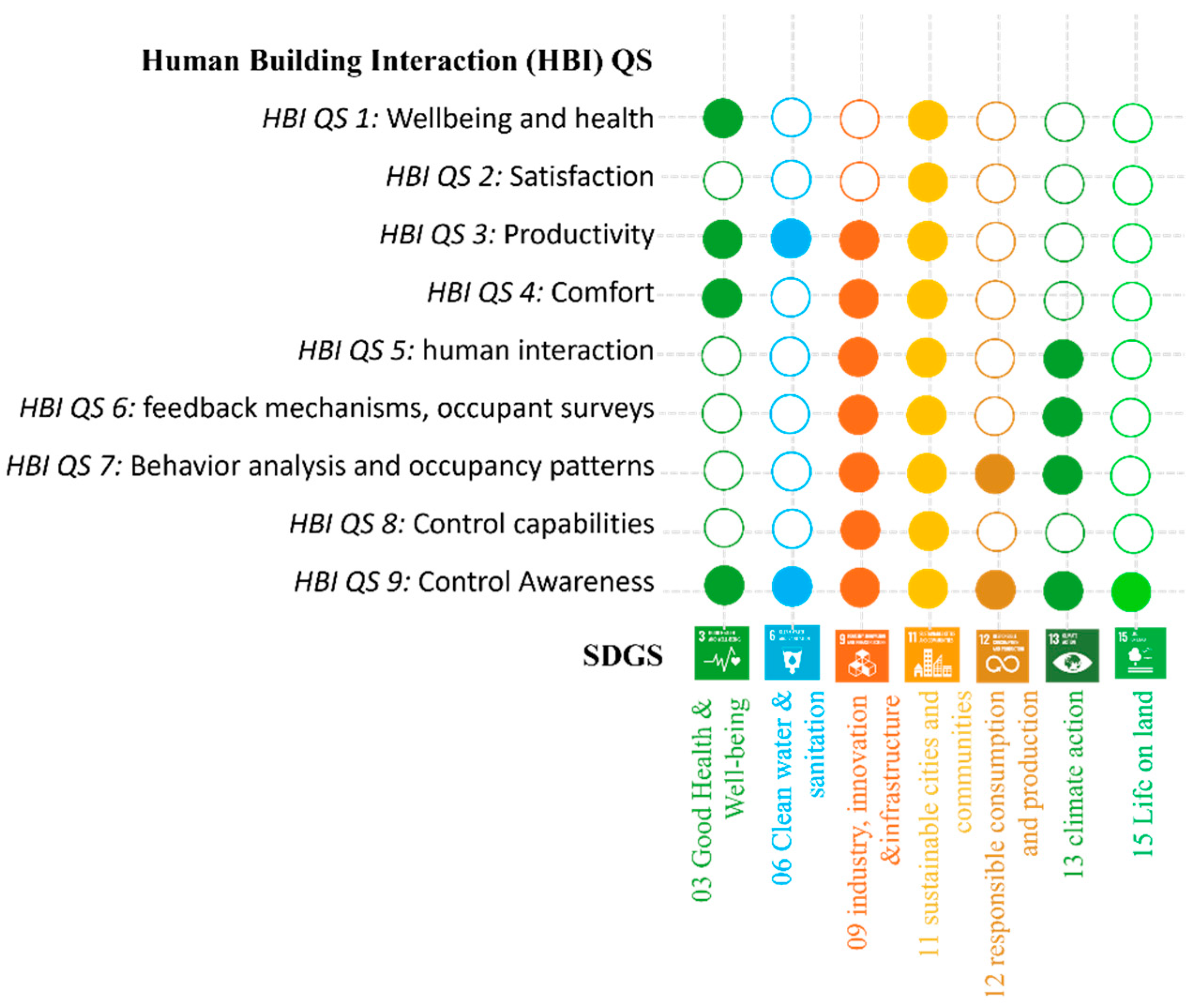
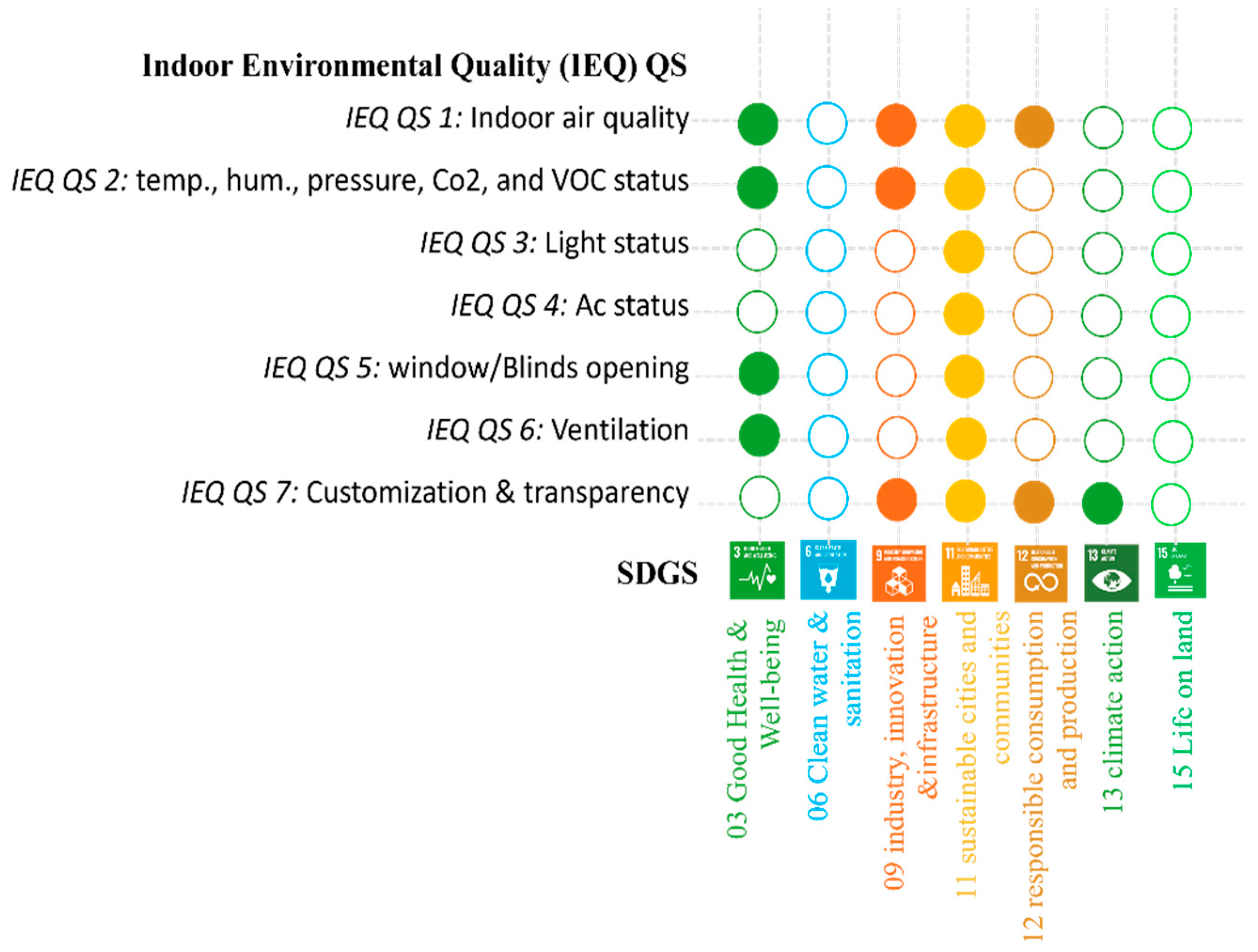

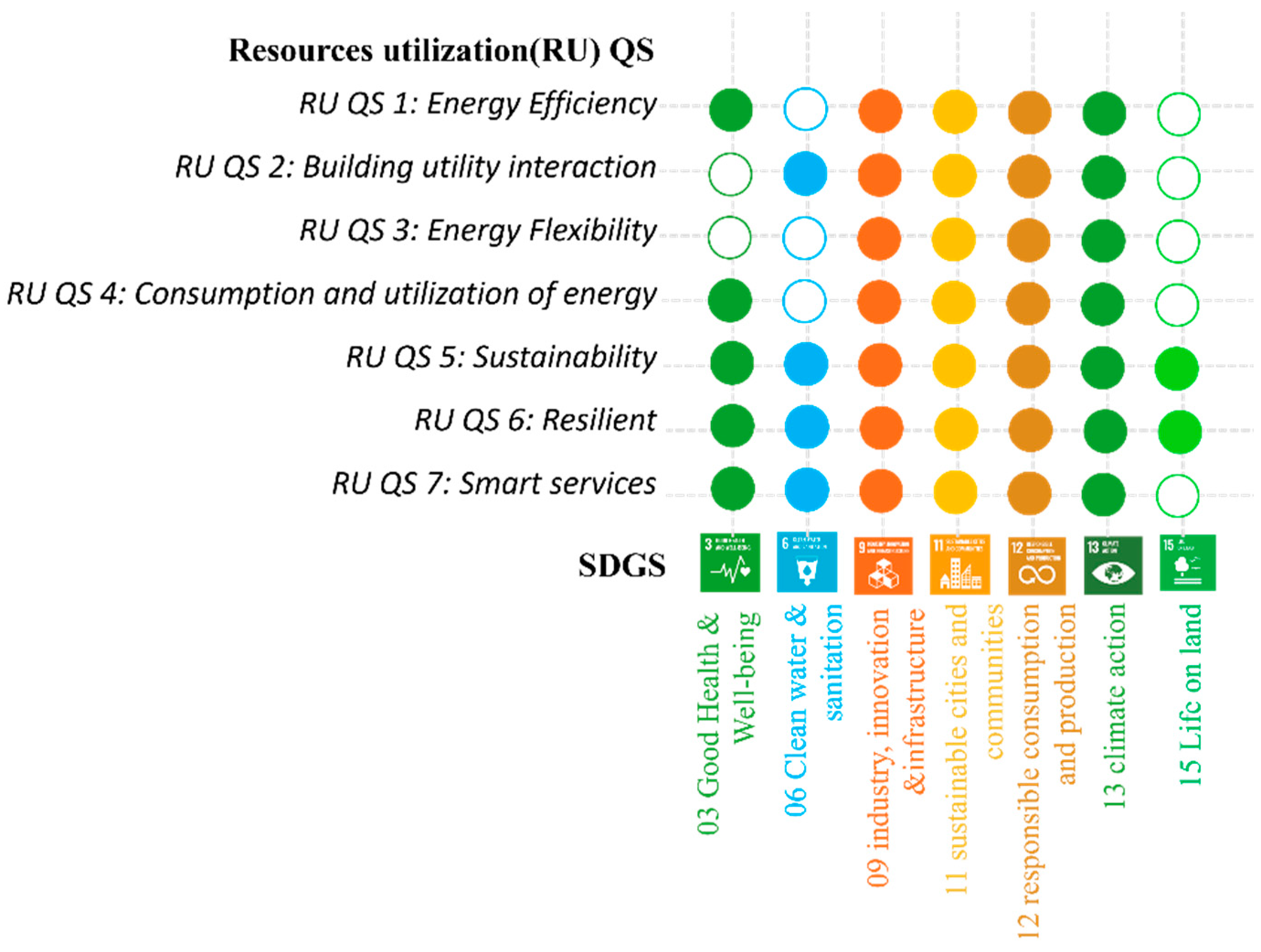
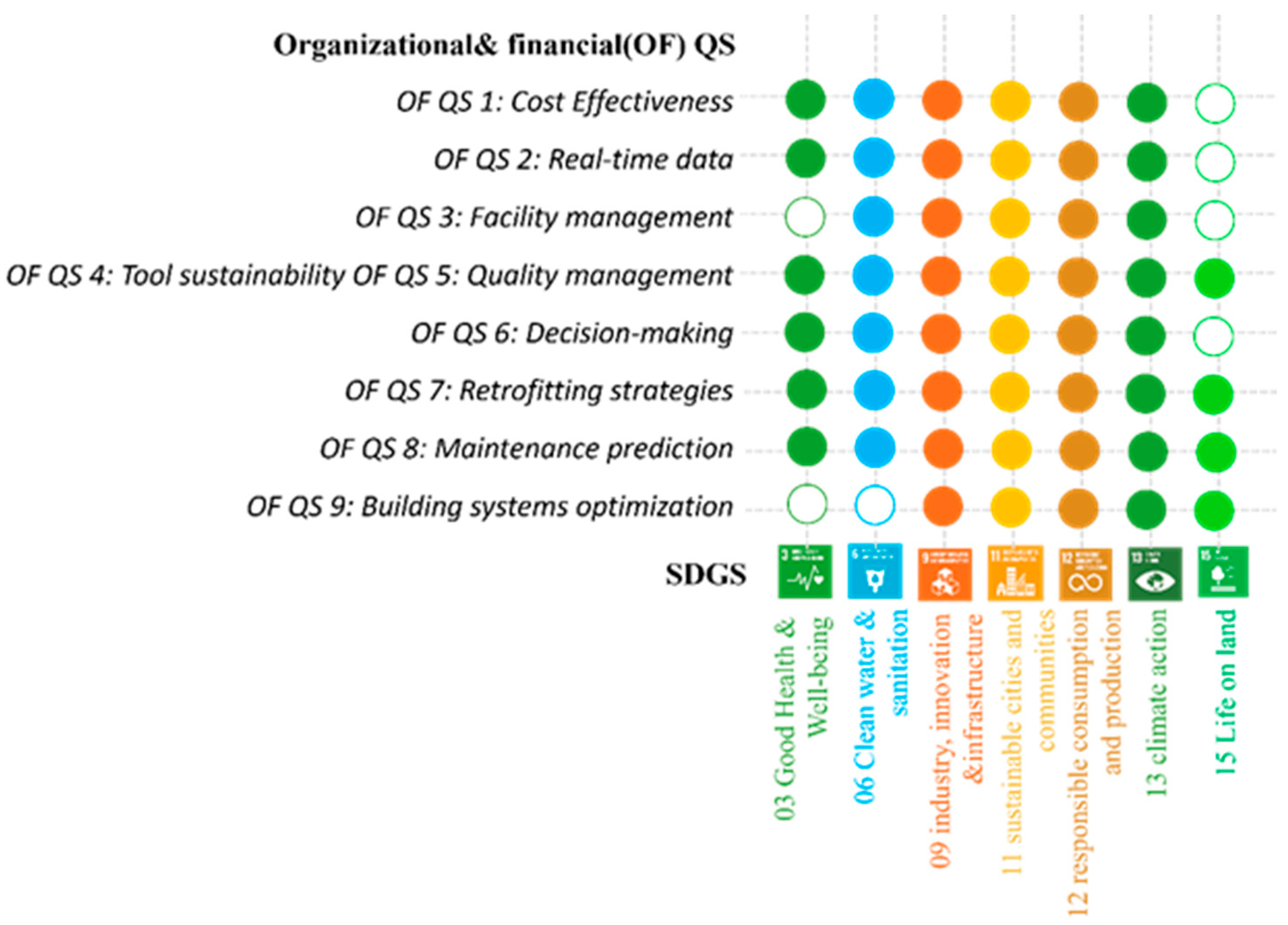

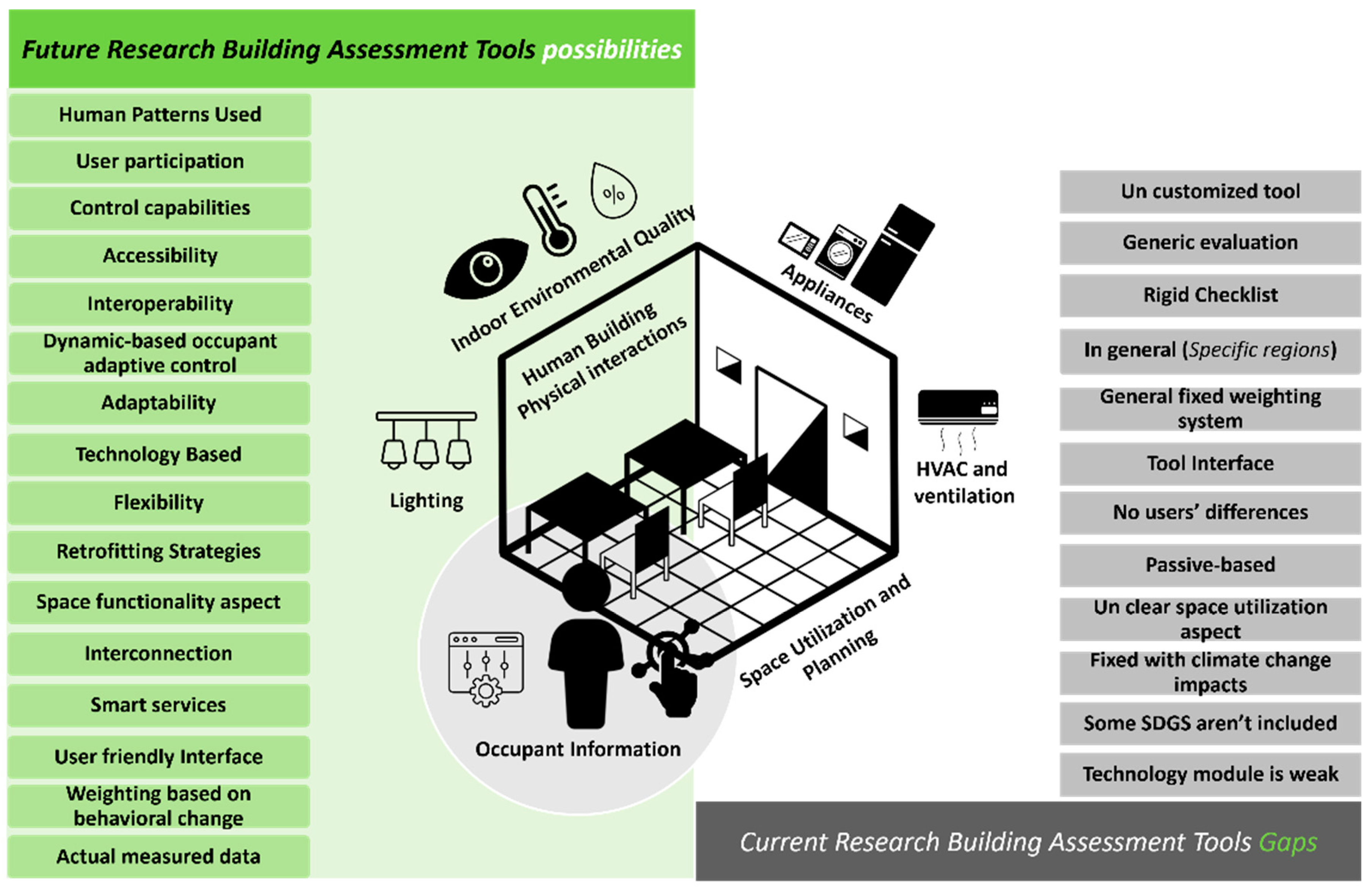
| Example Ref. | Indicator Code | IoT Application | Key Technologies | Aim |
|---|---|---|---|---|
| [106] | IoT Ind.1 | Occupant devices and wearables | Utilizing wearable devices, location awareness through Bluetooth low-energy (BLE) infrastructure, and image recognition with barcode tags and RFID technology. |
|
| [54] | IoT Ind.2 | Occupancy sensing intelligence and data | Leveraging smartphone applications, occupancy sensors, Microsoft’s Power Business Intelligence (Power BI) platform, and facilities management services provided by CBRE. |
|
| [107] | IoT Ind.3 | Geo-fencing and space utilization | Utilizing IoT software, sensors, and cloud platforms for data analysis. |
|
| [108] | IoT Ind.4 | Building a physical structure | Utilizing IoT software, sensors, and cloud platforms for data analysis. | Adapt the integration of the building’s orientation and form and the system. |
| [109] | IoT Ind.5 | Monitoring space utilities, such as lighting and HVAC | Leveraging IoT software, sensors, and cloud platforms for analysis, accessible through smartphones, tablets, or PCs. | Enable building managers to efficiently monitor multiple units and buildings, ensuring optimal operational efficiency, minimal energy consumption, and reduced overall life-cycle costs. Smart thermostats use occupant movement data to automatically adjust the temperature as needed. |
| [110] | IoT Ind.6 | Energy and facility management | Utilizing sensors, actuators, smart plugs, smart meters, and a universal home gateway (UHG). | Regulating high peak loads or during periods of high pricing can lead to savings in lighting, cooling, and overall costs, as the system can effectively shut down electronics in unused spaces. |
| [111] | IoT Ind.7 | Indoor Environmental Quality and Analysis | Utilizing sensors, actuators, smart plugs, smart meters, and a Hadoop system for the ingestion and analytics of big data. | Manage oxygen levels and luminosity and detect/smooth hazardous gases or smoke. |
Disclaimer/Publisher’s Note: The statements, opinions and data contained in all publications are solely those of the individual author(s) and contributor(s) and not of MDPI and/or the editor(s). MDPI and/or the editor(s) disclaim responsibility for any injury to people or property resulting from any ideas, methods, instructions or products referred to in the content. |
© 2024 by the authors. Licensee MDPI, Basel, Switzerland. This article is an open access article distributed under the terms and conditions of the Creative Commons Attribution (CC BY) license (https://creativecommons.org/licenses/by/4.0/).
Share and Cite
Metwally, E.A.; Ismail, M.R.; Farid, A.A. Advancing Building Assessment Tools: Achieving Sustainable Development Goals through the Fusion of Internet of Things Occupant-Centric Principles and Sustainable Practices. Buildings 2024, 14, 1798. https://doi.org/10.3390/buildings14061798
Metwally EA, Ismail MR, Farid AA. Advancing Building Assessment Tools: Achieving Sustainable Development Goals through the Fusion of Internet of Things Occupant-Centric Principles and Sustainable Practices. Buildings. 2024; 14(6):1798. https://doi.org/10.3390/buildings14061798
Chicago/Turabian StyleMetwally, Esraa A., Mostafa Refat Ismail, and Ayman A. Farid. 2024. "Advancing Building Assessment Tools: Achieving Sustainable Development Goals through the Fusion of Internet of Things Occupant-Centric Principles and Sustainable Practices" Buildings 14, no. 6: 1798. https://doi.org/10.3390/buildings14061798
APA StyleMetwally, E. A., Ismail, M. R., & Farid, A. A. (2024). Advancing Building Assessment Tools: Achieving Sustainable Development Goals through the Fusion of Internet of Things Occupant-Centric Principles and Sustainable Practices. Buildings, 14(6), 1798. https://doi.org/10.3390/buildings14061798






